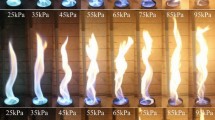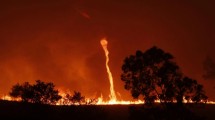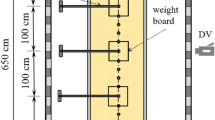Abstract
Jet fires generally leave patterns on the surface of the plate, which can be helpful for fire investigators to find the source and cause of fire incidents. However, the interaction between jet fires and wood plates still lacks research. This paper investigates the flame extension and pattern of jet fire impinging wood plates under strong plume conditions. The flame extension length beneath the plate is intensely studied. Moreover, an attempt is made to relate the fire patterns left by the jet fire impinging on the wood plate with the fire characteristic parameters. The results indicate that the flame extension length under the plates is strongly related to the visible free height, nozzle-plate height, and gas fuel velocity. The radius of the fire pattern is highly correlated with the flame extension length, and a new relationship equation between the radius of the fire pattern and the flame extension length is proposed. The area of the fire pattern is related to three characteristic parameters, the fuel flow rate, nozzle diameter, and nozzle-plate height, and the prediction equation of the fire pattern area is given to collapse all the experimental data well to provide theoretical support for fire investigation work.














Similar content being viewed by others
References
Swuste P, van Nunen K, Reniers G, Khakzad N (2019) Domino effects in chemical factories and clusters: an historical perspective and discussion. Process Saf Environ Prot 124:18–30
Cumber PS, Spearpoint M (2006) A computational flame length methodology for propane jet fires. Fire Saf J 41:215–228
Cumber PS, Onokpe O (2012) Predicting the mean and RMS fields in subsonic hydrogen jet fires. Fire Saf J 49:22–34
Gomez-Mares M, Zarate L, Casal J (2008) Jet fires and the domino effect. Fire Saf J 43:583–588
Mashhadimoslem H, Ghaemi A, Behroozi AH, Palacios A (2020) A New simplified calculation model of geometric thermal features of a vertical propane jet fire based on experimental and computational studies. Process Saf Environ Prot 135:301–314
Palacios A, Munoz M, Darbra RM, Casal J (2012) Thermal radiation from vertical jet fires. Fire Saf J 51:93–101
Wang C, Ding L, Wan H, Ji J, Huang Y (2021) Experimental study of flame morphology and size model of a horizontal jet flame impinging a wall. Process Saf Environ Prot 147:1009–1017
Morton BR (1965) Modeling fire plumes. Symp Combust 10:973–982
Morton BR (1959) Forced plumes. J Fluid Mech 5:151–163
Alpert RL (1972) Calculation of response time of ceiling-mounted fire detectors. Fire Technol 8:181–195
Alpert RL (1987) Convective heat transfer in the impingement region of a buoyant plume. J Heat Transfer 109:120–124
Alpert RL (1975) Turbulent ceiling-jet induced by large-scale fires. Combust Sci Technol 11:197–213
Heskestad G, Delichatsios MA (1979) The initial convective flow in fire. Symp Combust 17:1113–1123
Heskestad G, Hamada T (1993) Ceiling jets of strong fire plumes. Fire Saf J 21:69–82
You HZ, Faeth GM (1979) Ceiling heat-transfer during fire plume and fire impingement. Fire Mater 3:140–147
Wang C, Ji J (2022) Experimental study of fire plume temperature and radiant heat flux of a horizontal jet flame impinging a wall. Fire Saf J 129:103550
Schuhler E, Lecordier B, Yon J, Godard G, Coppalle A (2020) Experimental investigation of a low Reynolds number flame jet impinging flat plates. Int J Heat Mass Transfer 156:119856
Zhao Z, Wong TT, Leung CW (2004) Impinging premixed butane/air circular laminar flame jet: influence of impingement plate on heat transfer characteristics. Int J Heat Mass Transf 47:5021–5031
Wade C, Spearpoint M, Fleischmann C, Baker G, Abu A (2018) Predicting the fire dynamics of exposed timber surfaces in compartments using a two-zone model. Fire Technol 54:893–920
Bénichou N, Sultan MA (2000) Fire resistance performance of lightweight wood-framed assemblies. Fire Technol 36:184–219
Malanga R (1995) Fire endurance of lightweight wood trusses in building construction. Fire Technol 31:44–61
Odeen K (1985) Fire resistance of wood structures. Fire Technol 21:34–40
Kallada Janardhan R, Hostikka S (2019) Predictive computational fluid dynamics simulation of fire spread on wood cribs. Fire Technol 55:2245–2268
Clancy P (2002) A parametric study on the time-to-failure of wood framed walls in fire. Fire Technol 38:243–269
Oka Y, Ando M (2013) Temperature and velocity properties of a ceiling jet impinging on an unconfined inclined ceiling. Fire Saf J 55:97–105
Zhang X, Hu L, Zhu W, Zhang X, Yang L (2014) Flame extension length and temperature profile in thermal impinging flow of buoyant round jet upon a horizontal plate. Appl Therm Eng 73:15–22
Chen L, Du S, Zhang Y, Xie W, Zhang K (2019) Experimental study on the maximum temperature and flame extension length driven by strong plume in a longitudinal ventilated tunnel. Exp Thermal Fluid Sci 101:296–303
Wang Z, Zhou K, Zhang L, Nie X, Wu Y, Jiang J, Dederichs AS, He L (2021) Flame extension area and temperature profile of horizontal jet fire impinging on a vertical plate. Process Saf Environ Prot 147:547–558
You HZ (1985) An investigation of fire-plume impingement on a horizontal ceiling. 2—Impingement and ceiling-jet regions. Fire Mater 9:46–56
Richter F, Rein G (2020) A multiscale model of wood pyrolysis in fire to study the roles of chemistry and heat transfer at the mesoscale. Combust Flame 216:316–325
Abbasi-Atibeh E, Bergthorson JM (2019) Differential diffusion effects in counter-flow premixed hydrogen-enriched methane and propane flames. Proc Combust Inst 37:2399–2406
Qi X, Zhou S, Gao J, Zhu M, Zhang Z, Zhang D (2021) Counter-current flame propagation in a cylindrical bed of activated carbon saturated with artificial volatile matter in an upward flow of O2/N2 mixture. Proc Combust Inst 38:4251–4259
Ning D, Fan A, Yao H (2017) Effects of fuel composition and strain rate on NO emission of premixed counter-flow H2/CO/air flames. Int J Hydrog Energy 42:10466–10474
Safer K, Tabet F, Ouadha A, Safer M, Gökalp I (2014) Simulation of a syngas counter-flow diffusion flame structure and NO emissions in the pressure range 1–10atm. Fuel Process Technol 123:149–158
Bidabadi M, Hosseinzadeh S, Setareh M, Panahifar P, Sadeghi S (2018) Theoretical study of non-adiabatic counter-flow diffusion flames propagating through a volatile biomass fuel taking into account drying and vaporization processes. Fuel Process Technol 179:184–196
Sadeghi S, Bidabadi M (2021) Mathematical study of threshold of thermal-diffusive instability in counter-flow non-premixed biomass-fueled flames considering effective parameters. Comput Math Appl 81:602–617
Zhang G, Zhou X, Zhu G, Yan S (2019) A new accident analysis and investigation model for the complex building fire using numerical reconstruction. Case Stud Thermal Eng 14:100426
Otsu N (1979) Threshold selection method from gray-level histograms. IEEE Trans Syst Man Cybern 9:62–66
Audouin L, Kolb G, Torero JL, Most JM (1995) Average centerline temperatures of a buoyant pool fire obatained by image-processing of video recordings. Fire Saf J 24:167–187
Wang Z, Jiang K, Zhao K, Guo P (2021) Macroscopic characteristics and prediction model of horizontal extension length for syngas jet flame under inclined conditions. Int J Hydrog Energy 46:23091–23099
Li K, Mousavi M, Hostikka S (2017) Char cracking of medium density fibreboard due to thermal shock effect induced pyrolysis shrinkage. Fire Saf J 91:165–173
Baroudi D, Ferrantelli A, Li KY, Hostikka S (2017) A thermomechanical explanation for the topology of crack patterns observed on the surface of charred wood and particle fibreboard. Combust Flame 182:206–215
Bryden KM, Hagge MJ (2003) Modeling the combined impact of moisture and char shrinkage on the pyrolysis of a biomass particle. Fuel 82:1633–1644
McCaffrey FHB (1988). In: DiNenno PJ (ed) SFPE Fire protection handbook. National Fire Protection Association, Quincy, pp 298–305
Zukoski EE, Kubota T, Cetegen B (1981) Entrainment in fire plumes. Fire Saf J 3:107–121
Heskestad G (1983) Luminous heights of turbulent diffusion flames. Fire Saf J 5:103–108
Heskestad G (1998) On Q* and the dynamics of turbulent diffusion flames. Fire Saf J 30:215–227
da Silva FS, Aquino de Souza NCS, de Moraes MV, Abreu BJ, de Oliveira MF (2022) CmyoSize: an ImageJ macro for automated analysis of cardiomyocyte size in images of routine histology staining. Ann Anat Anatomischer Anzeiger 241:151892–151892
Zhou K, Jiang J (2016) Thermal radiation from vertical turbulent jet flame: line source model. J Heat Transfer-Trans Asme 138:042701
AbAziz NS, MdKasmani R, Samsudin MDM, Ahmad A (2019) Comparative analysis on semi-empirical models of jet fire for radiant heat estimation. Process Integr Optim Sustain 3:285–305
Bradley D, Gaskell PH, Gu X, Palacios A (2016) Jet flame heights, lift-off distances, and mean flame surface density for extensive ranges of fuels and flow rates. Combust Flame 164:400–409
Bradley D, Lawes M, Mansour MS (2011) Correlation of turbulent burning velocities of ethanol-air, measured in a fan-stirred bomb up to 12 MPa. Combust Flame 158:123–138
Huzayyin AS, Moneib HA, Shehatta MS, Attia AMA (2008) Laminar burning velocity and explosion index of LPG-air and propane-air mixtures. Fuel 87:39–57
Buckingham E (1914) On physically similar systems, illustrations of the use of dimensional equations. Phys Rev 4:345–376
Acknowledgements
This work was supported by the National Key Technology R&D Program (No. 2021YFB2402001), Suzhou Science and Technology Plan Project (No. SS202138), and Fundamental Research Funds for the Central Universities (Grant No. WK2320000053).
Author information
Authors and Affiliations
Corresponding author
Ethics declarations
Conflict of interest
The authors declare that they have no known competing financial interests or personal relationships that could have appeared to influence the work reported in this paper.
Additional information
Publisher’s Note
Springer Nature remains neutral with regard to jurisdictional claims in published maps and institutional affiliations.
Supplementary Information
Below is the link to the electronic supplementary material.
Rights and permissions
Springer Nature or its licensor (e.g. a society or other partner) holds exclusive rights to this article under a publishing agreement with the author(s) or other rightsholder(s); author self-archiving of the accepted manuscript version of this article is solely governed by the terms of such publishing agreement and applicable law.
About this article
Cite this article
Chen, X., Yu, X., Lin, Y. et al. Experimental Study on Flame Extension and Pattern Analysis of Jet Fire Impinging Wood Plates. Fire Technol 59, 359–380 (2023). https://doi.org/10.1007/s10694-022-01338-8
Received:
Accepted:
Published:
Issue Date:
DOI: https://doi.org/10.1007/s10694-022-01338-8




